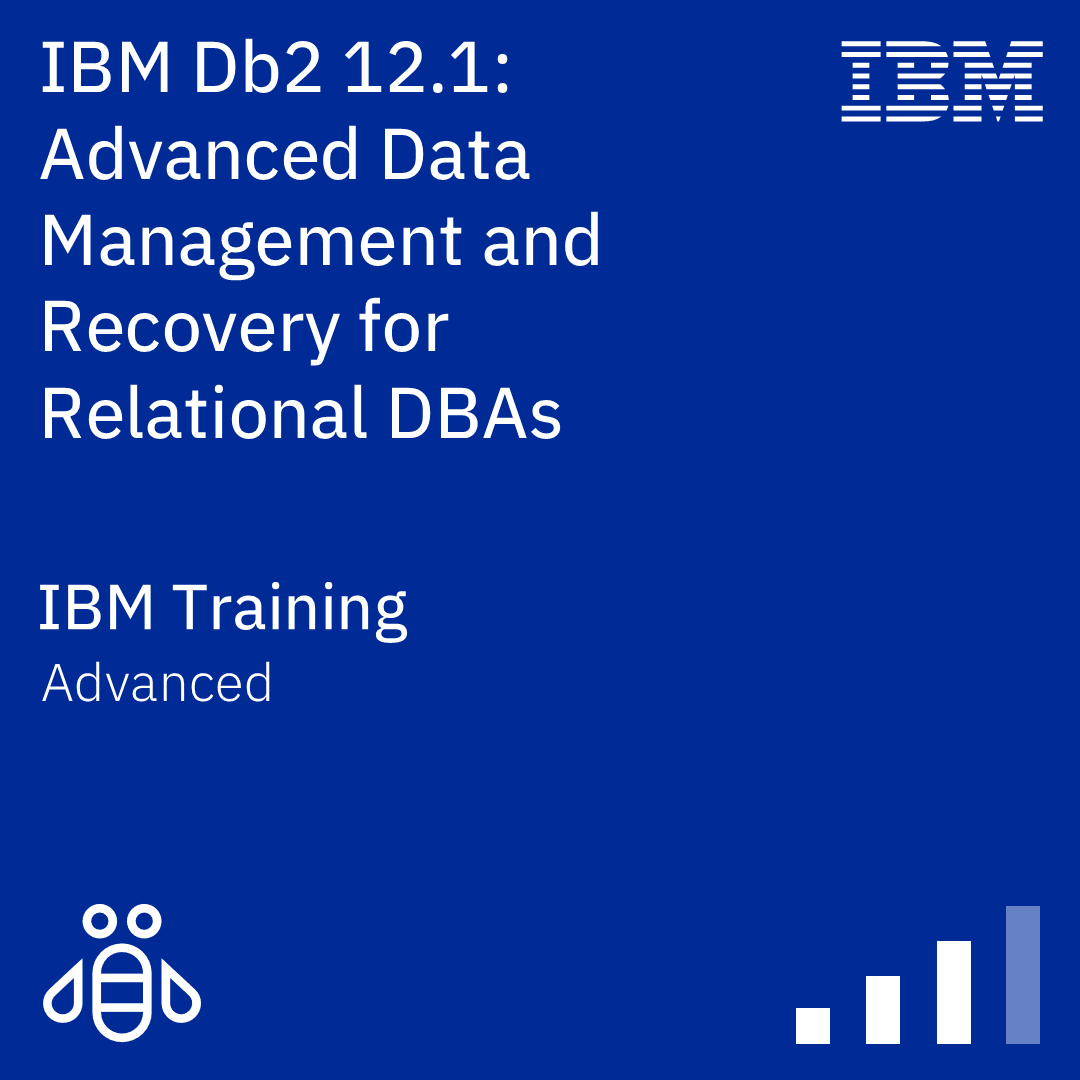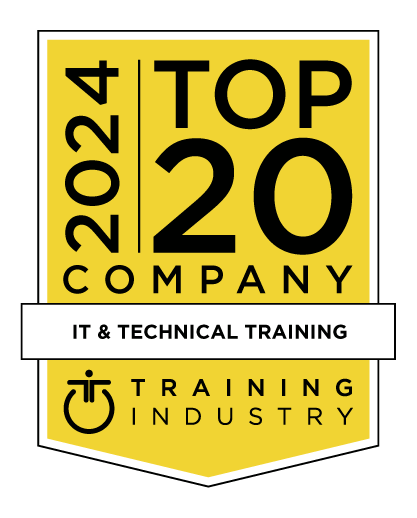title
Please take a moment to fill out this form. We will get back to you as soon as possible.
All fields marked with an asterisk (*) are mandatory.
IBM Db2 12.1: Advanced Data Management and Recovery for Relational DBAs
Course Description
Overview
This course provides learners with a comprehensive exploration of advanced techniques for managing and recovering data in Db2 12.1 environments. It begins with methods for efficiently moving and loading data, enabling database administrators to migrate schemas, relocate data, and integrate with external sources while maintaining system stability.
The course covers advanced backup and recovery strategies, from incremental backups and redirected restores to dropped table recovery and logical backups. Learners will also explore Db2 features that support high availability and disaster recovery, as well as specialized tools such as split mirror technology and the Db2 Advanced Recovery Feature.
Through a series of hands-on exercises, learners will practice applying these advanced techniques in real-world scenarios. Activities include using the LOAD utility with advanced options, moving data between databases with db2move and schema copy procedures, executing redirected restores, and recovering dropped tables. Participants will also gain practical experience with database maintenance tasks such as running RUNSTATS, reorganizing tables and indexes with REORG, and applying autonomic features to automate recurring maintenance operations.
By the end of this course, learners will be able to confidently manage complex data movement, implement robust backup and recovery procedures, and use Db2's autonomic features to sustain database performance and availability. They will be equipped with the expertise needed to reduce downtime, optimize efficiency, and safeguard critical enterprise data in advanced Db2 deployments.
Objectives
After completing this course, learners should be able to:
- Summarize the role of advanced Db2 utilities in data movement, recovery, and database maintenance.
- Apply advanced LOAD options and external table techniques to optimize data import and exchange.
- Use tools such as db2look and db2move to export structures and move data between Db2 databases.
- Execute administrative procedures, including DB2_ADMIN_COPY_SCHEMA and DB2_ADMIN_MOVE_TABLE, to streamline schema and table management.
- Perform incremental backups, redirected restores, and dropped table recovery to strengthen data protection strategies.
- Implement logical backups, split mirror technology, and Db2 Advanced Copy Services for high-performance recovery.
- Configure and manage Db2 High Availability and Disaster Recovery (HADR) and leverage the Db2 Advanced Recovery Feature.
- Apply statistics profiles and autonomic features to enhance performance tuning and reduce manual administration.
- Automate recurring maintenance tasks using the Administrative Task Scheduler and autonomic management of backups, statistics collection, and reorganizations.
Audience
This course is intended for experienced database administrators, system administrators, and technical professionals who manage Db2 environments and need to expand their expertise in advanced data movement, backup, recovery, and maintenance. It is also suitable for application developers and data engineers who work closely with Db2 databases and want to strengthen their understanding of utilities, schema handling, and performance optimization.
Prerequisites
- Completion of CLA90G: IBM Db2 12.1 Essentials for Relational DBAs or equivalent knowledge
- Completion of course CLA91G/2LA91G: Data Management and Recovery for Relational DBAs
- Prior experience with Db2 database administration
- Familiarity with Db2 utilities such as BACKUP, RESTORE, LOAD, and RUNSTATS
- Working knowledge of SQL and database objects (tables, indexes, and schemas)
- Basic understanding of database recovery concepts
- Hands-on practice in managing Db2 environments
Participants should have the following:
Topics
Unit 1: Data Movement and Loading
- Db2 Utilities Recap
- LOAD Performance and more
- Using db2move
- Using RESTORE
- Using db2relocatedb
- Using ADMIN_COPY_SCHEMA and ADMIN_MOVE_TABLE
- db2look
- Using External Tables
- 3 Hands-on Exercises
Unit 2: Backup and Recovery
- Incremental Backup and Recovery
- Table Space Recovery
- Db2 Database Rebuild Support
- Db2 RESTORE with REDIRECT
- Dropped Table Recovery
- Logical Backup and Restore
- Split Mirrors and Db2 Advanced Copy Services
- Db2 High Availability and Disaster Recovery (HADR)
- Db2 PureScale
- Db2 Merge Backup
- Db2 High Performance Unload
- Db2 Recovery Expert
- 3 Hands-on Exercises
Unit 3: Database Maintenance, Monitoring, and Problem Determination
- Using Statistics Profiles
- Autonomy Features: Configuration
- Autonomy Features: Administrative Task Scheduler
- Autonomic Utility Execution
- Autonomic Statistics Details
- 1 Hands-on Exercise
Recognition
When you complete the Instructor-Led version of this course, you will be eligible to earn a Training Badge that can be displayed on your website, business cards, and social media channels to demonstrate your mastery of the skills you learned here.
Learn more about our IBM Db2 Badge Program →Related Courses
-
IBM Db2 12.1: Performance and Tuning Optimization for Relational DBAs
CLA94G- Duration: 8 Hours
- Delivery Format: Classroom Training, Online Training
- Price: 895.00 USD
-
Db2 13 for z/OS Basic Database Administration
CV845G- Duration: 24 Hours
- Delivery Format: Classroom Training, Online Training
- Price: 2,685.00 USD
Self-Paced Training Info
Learn at your own pace with anytime, anywhere training
- Same in-demand topics as instructor-led public and private classes.
- Standalone learning or supplemental reinforcement.
- e-Learning content varies by course and technology.
- View the Self-Paced version of this outline and what is included in the SPVC course.
- Learn more about e-Learning
Course Added To Shopping Cart
bla
bla
bla
bla
bla
bla
Self-Paced Training Terms & Conditions
This is a Self-Paced virtual class; it is intended for students who do not need the support of a classroom instructor.
If you feel you would better benefit from having access to a Subject Matter Expert, please enroll in the Instructor-Led version instead. Minimal technical support is provided to address issues with accessing the platform or problems within the lab environment.
Before you enroll, review the system requirements to ensure that your system meets the minimum requirements for this course. AFTER YOU ARE ENROLLED IN THIS COURSE, YOU WILL NOT BE ABLE TO CANCEL YOUR ENROLLMENT. You are billed for the course when you submit the enrollment form. Self-Paced Virtual Classes are non-refundable. Once you purchase a Self-Paced Virtual Class, you will be charged the full price.
After you receive payment confirmation from LearnQuest, you will be sent further access instructions and time limits for your course from IBM.
IMPORTANT!!! If your course provides access to a hands-on lab (Virtual Lab Environment), you will have a specific number of days (varies course by course) on the remote lab platform to complete your hands-on labs. Do not start your lab until you are ready to use your lab time effectively. Time allotted in the virtual lab environment will be indicated once you log into your course. The self-paced format gives you the opportunity to complete the course at your convenience, at any location, and at your own pace. The course is available 24 hours a day.
If the course requires a remote lab system, the lab system access is allocated on a first-come, first-served basis. When you are not using the elab system, ensure that you suspend your elab to maximize your hours available to use the elab system. Note: This does not add additional days to your Lab Environment time frame.
Click the Skytap Connectivity Test button to ensure this computer's hardware, software and internet connection works with the SPVC Lab Environment.
Click the Skytap Connectivity Documentation button to read about the hardware, software and internet connection requirements.
Exam Terms & Conditions
Sorry, there are no classes that meet your criteria.
Please contact us to schedule a class.

STOP! Before You Leave
Save 0% on this course!
Take advantage of our online-only offer & save 0% on any course !
Promo Code skip0 will be applied to your registration
Purchase Information
title
Please take a moment to fill out this form. We will get back to you as soon as possible.
All fields marked with an asterisk (*) are mandatory.










